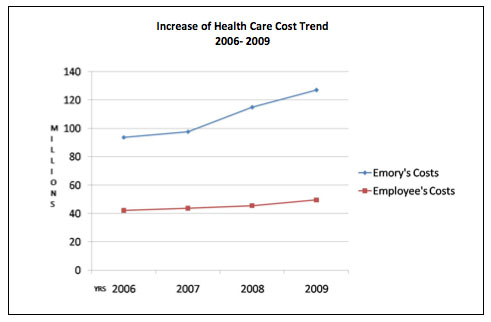Campus News
September 29, 2010
What impacts the cost of health care?
Katherine Hinson is director of HR Communications
Many of us are numb to the news of rising health care costs. But this news hits home when we get our benefits enrollment information for the coming year. And it becomes more of a reality when we see the changes to medical plan coverage and employee contributions.
Several factors impact the cost of health care for Emory and its employees. Over the last several years we have seen the cost of providing health care continue to increase (see chart) and do not anticipate it leveling out or declining in the future.
For 2011, it is estimated that Emory will see a 7 percent or $10 million increase in cost. Much of this rise in cost is attributed to increased utilization, higher reimbursements to physicians and hospitals, increased pharmacy costs, technology and the increased number of covered lives (i.e., employee plus dependents).
The recent Health Care Reform legislation mandates employers to provide coverage for children up to age 26, remove restrictions on pre-existing conditions for children, and remove lifetime maximums on medical plans. These requirements put a larger financial burden on employers and plan participants. Emory’s health care plans and costs will continue to evolve over the next few years as the implications of health care reform continue to be understood.
Costs also rise when health care consumers are not well informed and are not proactive in getting preventive care.
• Over 75 percent of Emory’s covered employees are potentially over-insuring themselves through their selection of the costliest plan offered. Those who are unaware of the coverage the plans offer and only look at the monthly (or biweekly) amount deducted from their paycheck may be paying more each month to avoid higher co-pays, deductibles and co-insurance. However, those who do not use the doctor frequently are basically paying to potentially avoid higher fees.
• By taking advantage of free services such as preventive care offerings, the screenings offered by the Faculty Staff Assistance Program, and resources offered by Aetna, an employee can help stave off unnecessary medical costs, reduce the potential for frequent doctor visits, and reduce out-of-pocket expenses.
Emory will continue to absorb as much of these costs as is feasible. But Emory will also continue to negotiate with providers for the best prices, evaluate plan designs and features to ensure that they are sustainable and affordable, and when necessary cost-share with employees.
In the meantime, employees can do their part to manage costs by becoming better informed and proactive health care consumers. At the end of the day, we will continue to see the costs of our health care rise. It is a reality that we must all face.

